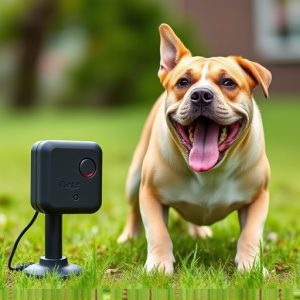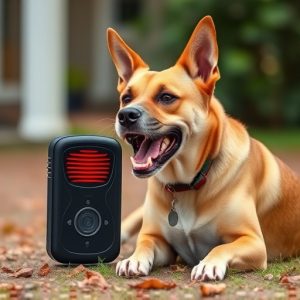Adjusting Sonic Repellent Training: Effective Animal Control Solutions
Sonic repellents, an innovative and eco-friendly animal control solution, use high-frequency sound w…….
Sonic repellents, an innovative and eco-friendly animal control solution, use high-frequency sound waves to deter critters. Their effectiveness lies in customizable training levels based on species, sensitivity, and terrain. This precise approach allows for managing animal populations, from keeping residential areas pest-free to protecting crops without harming wildlife. Adjusting training levels is crucial, involving understanding target species' hearing and behavioral responses, strategic placement, and adherence to environmental regulations. The Animal Control Sonic Repellent System offers humane deterrence in various settings, from homes to conservation areas, agriculture, and industrial sites, with future enhancements promising improved technology for optimal results.
“Discover the revolutionary power of Animal Control Sonic Repellent Systems – a non-lethal, eco-friendly solution for managing wildlife. This comprehensive guide explores the science behind sonic repellents and their proven efficacy in scaring away unwanted visitors. From understanding sound waves to fine-tuning training levels, we break down the process step-by-step. Learn about the diverse applications in residential, commercial, and public spaces, as well as safety precautions to ensure human and animal welfare. Plus, discover future enhancements that could transform wildlife management.”
- Understanding Sonic Repellents and Their Efficacy
- Adjusting Training Levels: A Step-by-Step Guide
- Benefits and Applications in Different Settings
- Safety Precautions and Future Enhancements
Understanding Sonic Repellents and Their Efficacy
Sonic repellents have emerged as a innovative solution for animal control, utilizing high-frequency sound waves to deter unwanted critters. Unlike traditional methods that rely on chemicals or physical barriers, sonic technology offers a humane and environmentally friendly alternative. These devices emit ultrasonic sounds beyond human hearing range, creating an uncomfortable sensation in animals, prompting them to avoid the area.
The efficacy of sonic repellents lies in their ability to be tailored to specific animal behaviors and environments. Adjusting sonic repellent training levels allows for customization based on factors like species, sensitivity, and terrain. By fine-tuning the frequency, decibel level, and pattern of sound waves, these systems can become highly effective tools for managing animal populations, from keeping rodents away from homes to protecting crops from wildlife damage.
Adjusting Training Levels: A Step-by-Step Guide
Adjusting the training levels in a sonic repellent system is an essential step to ensure its effectiveness in managing animal behavior. This process involves fine-tuning the device’s settings to match the specific needs and sensitivity of the target animals. Here’s a step-by-step guide to help you navigate this adjustment:
1. Identify Target Species: Begin by understanding the species you’re trying to repel. Different animals have varying hearing sensitivities and behavioral responses. Adjusting the training level should consider these factors, ensuring the frequency and intensity of the sonic signal are suitable for the intended target.
2. Set Initial Training Level: Start with a low training level and gradually increase it while observing the animal’s reaction. Many sonic repellent systems offer progressive levels, allowing you to start gently and cause minimal disruption before finding the optimal setting that effectively deters the animals without causing discomfort or stress.
3. Monitor and Adjust: As you train the system, closely monitor the behavior of the target animals. Look for signs of distress, avoidance, or habituation. If animals seem undisturbed by the current level, increment it slightly until a noticeable change in behavior is observed. The goal is to find a balance where the animals are deterred without being overly agitated.
4. Consider Environmental Factors: Outdoor conditions like temperature and humidity can affect sound transmission. In some cases, higher training levels might be necessary to penetrate background noises or environmental interference. Adjust accordingly, ensuring that the setting remains effective but comfortable for both animals and humans in the vicinity.
Benefits and Applications in Different Settings
The Animal Control Sonic Repellent System offers a non-lethal, humane approach to deterring unwanted wildlife from various settings. One of its key benefits is adaptability; by adjusting the sonic repellent training levels, this system can cater to diverse environments and species. For residential areas, lower setting levels ensure minimal disruption while effectively repelling animals like squirrels or raccoons. In more sensitive ecological zones, higher settings can be employed without causing harm to local wildlife, making it an ideal solution for parks and conservation areas.
Commercial and industrial sites also benefit from this technology. Lowered sound levels can deter birds from landing on rooftops or windowsills, preventing damage and ensuring clear views. Adjusting the training levels allows for a tailored approach in agricultural settings too, keeping animals away from crops without disturbing nearby habitats. This versatility makes the sonic repellent system a versatile tool for maintaining harmony between humans and wildlife.
Safety Precautions and Future Enhancements
When implementing an animal control sonic repellent system, safety precautions are paramount. These devices emit high-frequency sound waves that are generally harmless to humans and domestic animals but can effectively deter wildlife. However, it’s crucial to ensure proper usage and placement to avoid any potential discomfort or harm to sensitive species. Regular maintenance and testing are essential to guarantee the system functions optimally while adhering to environmental regulations.
Future enhancements in sonic repellent technology offer promising avenues for improvement. Adjusting sonic repellent training levels based on real-time data and feedback mechanisms can enhance both effectiveness and user experience. Incorporating smart sensors and AI algorithms could allow these systems to adapt to changing environments, becoming more precise and less disruptive. Such advancements hold the key to creating a harmonious coexistence between humans and wildlife.
Animal control sonic repellent systems offer a non-lethal, environmentally friendly solution for managing unwanted wildlife. By understanding their efficacy and adjusting training levels effectively, as outlined in this guide, these systems can be highly successful across various settings. With ongoing research and safety precautions, sonic repellents are poised to play an even greater role in humane animal control methods, making our spaces safer and more harmonious for both humans and animals.


